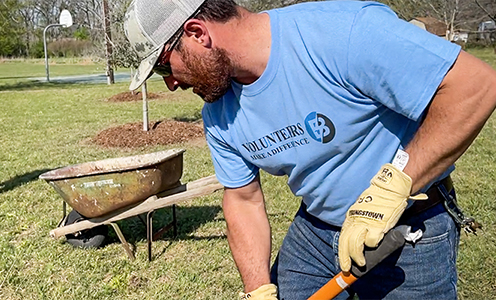Attics in Whisper Valley are insulated with spray polyurethane foam, which seals the space and reduces unwanted humidity, mold, pollen and air infiltration. The box in the center houses the home’s geothermal pump, which transfers the warmth or coolness of the water into air that will warm or cool living spaces.
After doing more than 1,300 in-home consultations over 35 years, Peter Pfeiffer of Barley|Pfeiffer Architecture knows about “building green.” Pfeiffer has earned much national recognition as a pioneer in environmentally sensitive architecture and in bringing green building to the mainstream. Pfeiffer, who often speaks about such trends, offers Bluebonnet members these suggestions:
Stop air leaks indoors
Close the chimney flue when the fireplace isn’t used because it lets hot, humid air seep down into the home. Check the weather-stripping around exterior doors, including the one leading to the garage. Kitchen and bath exhaust flaps should close when exhaust fans are not running. That will prevent a back-flow of outdoor air into the home.
Get an expert to test your air-conditioning system ducts for leaks. Leaking ducts in the attic, crawl space or floor cavities waste cool air and draw hot, humid air in from outside, down the chimney or from the garage.
Block the sun’s radiation from windows and glass doors
Windows facing the morning sun (east) and afternoon sun (west and south) should be shaded. Extended roof overhangs or permanent awnings will also reduce glare and eye strain and keep rain off windows (keeping them cleaner and extending their life). Solar screens are the next best way to reduce solar heat in your home. Half-screens on the lower half of the window also help. If nothing else, the insect screens that came with your windows help reduce the sun’s heat. Solar film is not as effective because the glass still radiates the sun’s heat into the home. Closing indoor shades, curtains and shutters help, but that’s the least effective method because heat has already entered the house through windows.
Reduce the sun’s effect on your home’s exterior
Don’t use dark colors on the exterior. Light-colored exteriors keep the house cooler and don’t fade as much or as quickly as dark colors. Choose light-colored limestone over darker-colored or red brick. Avoid dark-colored roofing shingles. Instead, consider light-colored metal roofing, along with a radiant barrier on the underside of the roof in the attic.
Indoor lighting — it’s not just about LED bulbs
Promote the beneficial use of indirect sunlight coming into your home. Daylight is free lighting. Open your blinds and window coverings when those windows do not have direct sunlight. Choose light-colored countertops in your kitchen and bathrooms: They reflect light and reduce the need for artificial light. Light-colored flooring also better reflects light and reduces energy use.
Avoid recessed light fixtures in a high ceiling because they require more energy to project light down where you need it. Strategically place task lighting: Hanging lights above your kitchen island or work counter that are close to your head are better than light fixtures in the ceiling. Table and floor lamps are more efficient for reading than recessed lights in the ceiling. High-performance fluorescents and LED lamps are energy efficient and emit less heat.
Have a pool? It may use as much energy as the entire house!
Run water through pool filters no more than 12 hours a day in the summer. Keep the filter clean because clogged filters increase the energy draw of the pool pump. Pool cleaning devices only need to run as needed, rather than on a schedule. Try just three hours once a week. Replace old, inefficient pool pumps, and make sure all pool equipment is working.
The latest ways to go green
Experts suggest a focus on these key areas to improve efficiency:
- Variable speed HVAC systems, good ductwork and placing the air conditioner in the attic, centering it above the interior space it’s going to cool.
- Moving insulation from above the ceiling up to the roofline, using spray foam insulation rather than loose-fill. That allows the AC system to be placed in a cooler location underneath the insulation, rather than in a space that’s hotter in summer.
- Metal or tile roofs are preferred over traditional shingles, which will transfer heat to the house.





